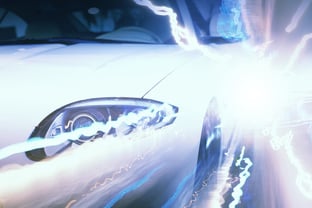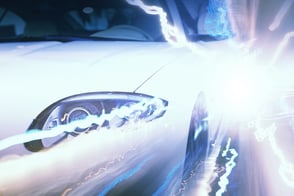Estimated Read Time: 13 minutes

In the last 48 hours, we have received countless emails. Everything from the 6 PPAI and ASI promotional emails we get per day to typical spam, while other emails are relevant to current projects or are leads. Then there are the emails that go down a rabbit hole that makes you wish you could be on whatever Lewis Carroll had.
What emails are these? Don’t worry; we can give you examples because we have emails like these metaphorically piling up to our eyeballs.
#1:
Hello,
Attached is a photo. I think it’s around 30 centimeters tall. I need it by December and around 5-10 of them.
Thanks,
Vickie V. from Company XYZ
#2:
Hi,
I need some cool looking awards for some clients. Maybe something with a car in it? Here’s a photo to inspire you. No budget.

Isaac Inspiration from ABC Company
#3:
Here’s a list of clients. Whip up some graphics for a meeting.
ABC University
8675309 Tech Company
JKLM Manufacturing
C3PO Hospitality
567 Insurance
1A2B Consumer Goods
987 Media
R2D2 Beverages
Need these soon.
Franny F. from Company 123
Today, we got a boatload of these. Yes, we like Distributors reaching out, but when not thought through beforehand, emails are just time-wasters, especially since they require so much back and forth. If you read on, we will walk you through each section of these emails. And, yes, each very brief email tells us in oh so many ways that you have no idea what the h*ll you are doing.
How? We will gladly teach so you so you will learn from the mistakes of your failed comrades.
Why Should You Care?
Before we jump into bisecting each email and giving snarky commentary along the way, I’m sure many are wondering, “What is the point of this? Why should I read on? Why should I even care?”
What was the point of this rant? That’s easy. We can’t help you unless you help us. So many distributors are rushing about so much, they don’t stop to consider and implement a few important factors that could really make their lives easier. So, in order to ease what can otherwise become a tense relationship, let’s cut to the chase and give you some tips that (if you choose to follow) will make quite a difference.
Following our tips, suddenly you are talking with the right people and the initial email confusion is greatly reduced. So, why should you care or read on? Because a supplier is providing you insights into streamlining processes that are nothing but frustrating for both parties right now. Wouldn’t you like to increase efficiency, even just a little?
Email #1: Ms. Vickie Vague
Here’s the email again so you can look at it.
Hello,
Attached is a photo. I think it’s around 30 centimeters tall. I need it by December and around 5-10 of them.
Thanks,
Vickie V. from Company XYZ
So, how many things can you count wrong in this email? Zero? Two? Five?
There are six.
I’ll list them for you.
1. Hello. No, “Hi Kristina” or “Hey Dave.” This tells us that this email was sent to a massive net of other suppliers and you’re fishing. We are not stupid; we can see what you are doing. Of the few emails you get back from this “blast,” you are looking for “bids.” Then you’ll just go with the lowest price, which may not represent the best overall value proposition. That’s because distributors typically don’t know what to look for when it comes to purely custom.
Pro Tip: To solve the “e-blast issue,” you should have one or two suppliers to check with first on your project. Building that relationship means suppliers are more willing to help you, plus you will get more relevant and prompt answers to your questions. If they can’t help you, then at least they can recommend others.
2. Attached is a photo. This person attached a blurry and sideways photo. We had to sit there staring at the photo for a while to give an estimated guess on what it is. Please take the time to take a clear photo and make it easy for us to see and understand it. Do what you would like us to do for you. If you make it clear what you are looking for and what we are looking at, then we can get back with you faster, with more relevant answers, and we won’t have to keep asking questions that waste both of our time. Hence, put an extra minute or two upfront, then it saves you exponentially more time in the long run by decreasing the questions that could have been answered in the beginning.
3. “I think” and “around.” Ms. Vague is exactly what her name suggests, she is vague. As a manufacturer, even an inch matters. So, the more information you can provide the closer in pricing we can provide. We need to know that the plaque needs to be 12 x 15 and a 5 inch depth. Oh, and the client seems to like wood and wants it to hang it and not be on a desk.
All of those details are vital for us to answer you. Holding info close to your breast is only going to hurt you. We can’t do our job and answer your questions without knowing what we are supposed to quote you. Please, please use specifics and be accurate.
4. By December. Did you know that December is a whole month? You did? Then why did you make a month the due date? We need to understand if it’s due in 2 weeks or 6. That makes a difference if it’s a rush job or not.
5. 5 to 10. It’s best to have a number in mind of how many products you want. However, at least Vickie provided us with numbers. Just please, the smaller the range, and the more accurate, the better.
6. No budget. No matter what, there is always a budget. We need to know what that budget is because that defines materials, size, creatives, and much more. Hiding the budget, which you typically already know, is useless. We get it, it’s a negotiating technique, but at least give us a range so we can all start on the same page. For custom pieces like what we do, they can be anywhere from $5 to $100,000+ per piece. So, for us to have a beneficial relationship, we need to be honest and upfront with each other.
The moral of this email story is to be upfront and specific, while also being respectful. If you pick a few of your favorite suppliers and give them all the info in the beginning, then they’re in a better position to be more transparent and helpful with you too.
Email #2: Mr. Inspiration
Here’s the email again.
Hi,
I need some cool looking awards for some clients. Maybe something with a car in it? Here’s a photo to inspire you. No budget.

Isaac Inspiration from ABC Company
Let’s try the same exercise as before since you now have one email guessing game under your belt. How many mistakes are in this email?
Answer: 8
1. No personalization. If we sent you an email, you would want us to call you by name, right? Then please give us with the same respect and courtesy.
2. Some clients. We get that you want to keep some info to yourselves; you’re scared that suppliers will take out the middleman (you). However, how can you expect us to create visuals without a name or logo?
3. Just an image. From the above image, I would guess that it’s a car, headlight, or car paint manufacturer, or a car sales company. But that’s just guessing from what the photo shows us, but it could be something else completely, like you just wanted the cool effect that is going on here. You have to tell us, we can’t read your mind.
4. Something. What is this “something?” A wall plaque? An object to sit on the desk? Or a full custom award? There are hundreds of thousands of directions we can go. That’s the great thing about custom; however, that’s also a problem when we don’t know what you or your client are looking for.
5. Something with a car in it. Do you have any idea how many parts and angles there are to a car? And do you have any idea on how many types, brands, and models of cars there are out there? If your client is a car manufacturer, we can guarantee that they won’t want someone else’s vehicle on the example. We need to know details.
6. No budget. There is no such thing as “no budget.” We work with a variety of budgets, from $5 to over hundreds of thousands of dollars. We are not a plug and play company, we are custom, and so budget is vital for us to give you the best recommendations. If you don’t feel comfortable in giving us the budget right at the beginning, even a relevant range is better than nothing (please don’t say that the budget can be anything from $1 to a million).
7. No deadlines. There is always a deadline. Awards are given at a special time, by telling us at the beginning, we can tell you how slow or quickly the creative, approval, manufacturing, and shipping segments can be. We can also tell you if there’s a rush charge upfront so you can already factor that into your amounts, we don’t like surprise costs and hitches any more than you do.
8. No further detail or information. How many do you want? Who is this for in the company – a sales person, a founder, an employee for his anniversary, or upper management? The more information we are provided, the more useful we can be. Custom is not like a plug and play (you have a product you find online, plug in the logo, and purchase it all online). That’s not how custom business models work. We have to have conversations and understand what you both are looking for.
So, what’s the morale of this story? Having visuals and images are great, but we need more information, details, and explanation to actually answer your questions and needs. Otherwise you will have to deal with multiple emails back and forth to understand the project more, which could have prevented by taking the time in the beginning.
Pro Tip: Did you know that humans can’t actually multitask? We like to think so, but respectable sources are saying otherwise. So, please stop multitasking, which only leads to sloppy work like these emails. Instead put some of that fabulous brainpower towards respecting your partners to have a fruitful conversation.
Email #: Ms. Franny Freebee
Here’s the last email, you can look at it again here.
Here’s a list of clients. Whip up some graphics for a meeting.
ABC University
8675309 Tech Company
JK Manufacturing
C3PO Hospitality
567 Insurance
1A2B Consumer Goods
987 Media
R2D2 Beverages
Need these soon.
Franny F. from Company 123
Playing our guessing game again (add up your score at the end to see how you really did), how many #EmailFails are there?
Answer: 9
1. No salutation. Not even a hello or thanks at the end. How rude.
2. Whip up. Every company and segment of the industry is different. Whipping up proofs and digital copies might be simple for a cap or mug company, but that’s a tall order for custom. We aren’t just an “insert logo here” company. So, when you ask for visuals, you are asking us to give you a lot of hours for free which are not realistic for a business model, especially when you are just using this to get in the door. Use our portfolio of case studies, that’s the best way to show custom without both of us putting in a lot of man hours that likely will never come to fruition. Also, art is not something that happens with a snap of fingers, it takes time, talent, imagination, and experience, please respect it as such.
3. Some graphics. How specific. Are you thinking a plaque, a desk commemorative, or a trophy that will be given to the winner of a race? We have no idea what you are wanting; you have to at least give us an idea. If you don’t know, then we can start the conversation with a blank sheet of paper and proceed, but that requires a conversation and more than just a list in an email.
4. Want some graphics for a meeting. This tells us that you do not have a lead. You are using our work to get a foot in the door. Do you have any idea how many distributors are out there? If we did 8 visuals like Ms. Freebee is wanting for all the listed clients, we would never do anything else. So, rather than having us put in the man hours in the front end (and unless you are willing to pay for the man hours you are asking us to put in for free), please use our portfolio. That’s just as good for a meeting. You are a good enough salesperson to be able to use a portfolio for the sales process, we believe in you.
5. Need these soon. How specific. Trying to create a sense of vague urgency, great. Do you like it when someone emails you that? No? Then why email that to someone else? Also, for future reference, deadlines are always the best policy and we can tell you if the date is doable or not.
6. No budgets. What have we been saying the whole time – there is no such thing as “no budget.” Companies did not get where they are now by not planning out a budget, there is always a set amount or a range. By telling us the budget, we can find the best solution for you and your clients.
7. No ideas. All we got was a list of names. Ok, great, but what are we supposed to do with these names? We can’t read your mind. You have to give us a description, a sketch, or some words strung together.
8. No details. Are you picturing this to be as tall as a human adult? Or how about as small as a paperweight? Do you want something for a paper to go in? There are millions of options and ideas, please provide some details for us to be able to help you.
9. No actual leads. The sales process is for a sales person to go out and get a bid or a prospect, go to the supplier to nail down what the product will be, and then once chosen and approved by the client, the supplier will produce. By coming to the supplier before the client meeting, the sales process is now out of rhythm. You do your part and we will do ours.
Suppliers will gladly help, but you have to give us what we need to help (information) and you have to respect us like you want us to respect you. This is a partnership, so everyone should be open, honest, and respectful.
As a supplier, we are happy to answer emails and assist distributors, we just ask for more time taken in the initial emails to give us the vital information for us to help you. If you send us an email with vague information, just inspiration with no details, or just asking for free labor, we will instantly know that you have no idea how to work with or sell custom. Now, if you don’t know how to sell custom, we will gladly provide resources and guidance, but please don’t treat us like a dog on a leash that you can jerk around. We see it as a partnership that can blossom with some mutual respect and open sharing of information.
If you would like to see what questions we will ask you when we start a relationship, then check out this page. If you would like some tips of how to sell custom or would like to get some tools for employee recognition, be sure to stop by our blog. If you just want to reach out and start a conversation, or would like some guidance on what a supplier needs, then please feel free to contact us.
![]() Kristina Hublar is the Marketing Specialist at Bruce Fox, Inc., which means she is the person behind the keyboard for the social media, emails, website, and other marketing efforts. She’s new to Bruce Fox, but is an Indiana native. In her spare time, you’ll find her plotting her next road trip, bobbing along to music while crafting, spending time outside with loved ones, or with her nose in a book.
Kristina Hublar is the Marketing Specialist at Bruce Fox, Inc., which means she is the person behind the keyboard for the social media, emails, website, and other marketing efforts. She’s new to Bruce Fox, but is an Indiana native. In her spare time, you’ll find her plotting her next road trip, bobbing along to music while crafting, spending time outside with loved ones, or with her nose in a book.







